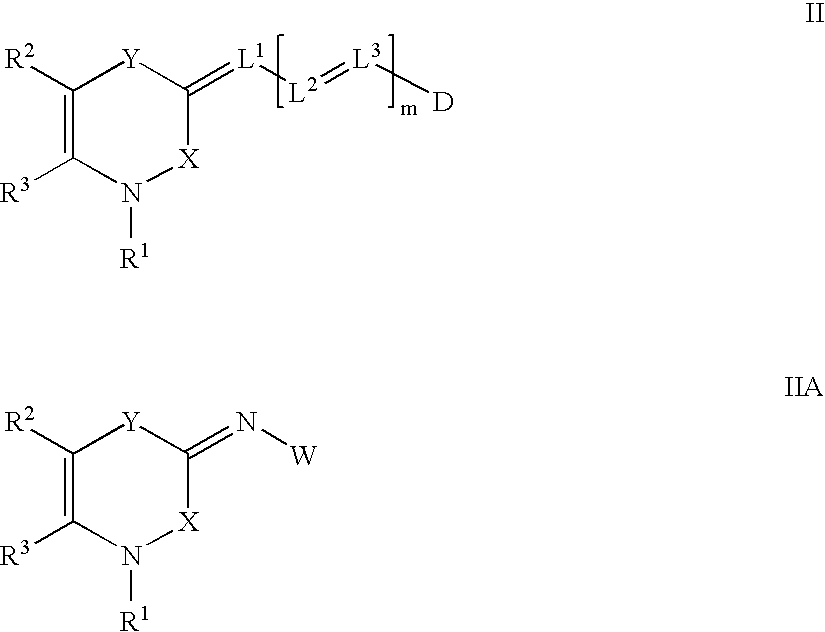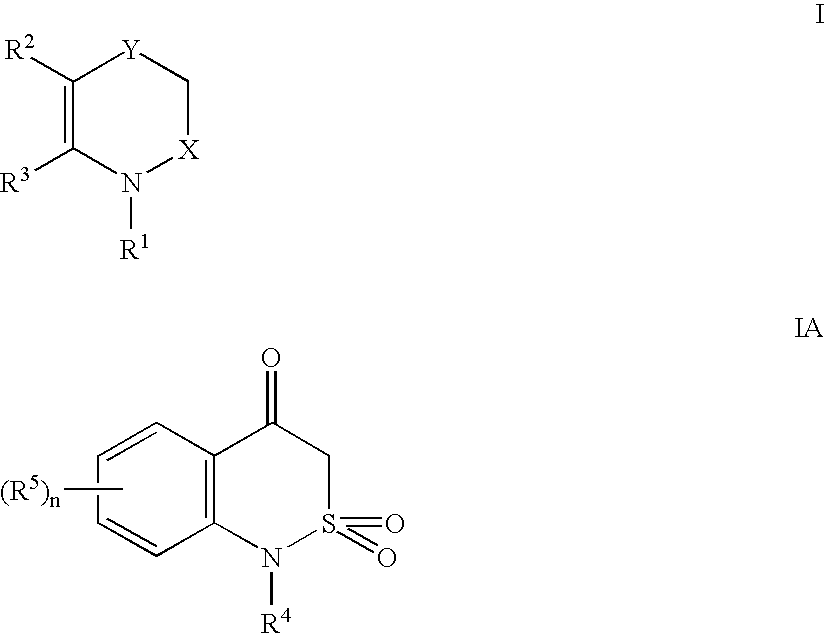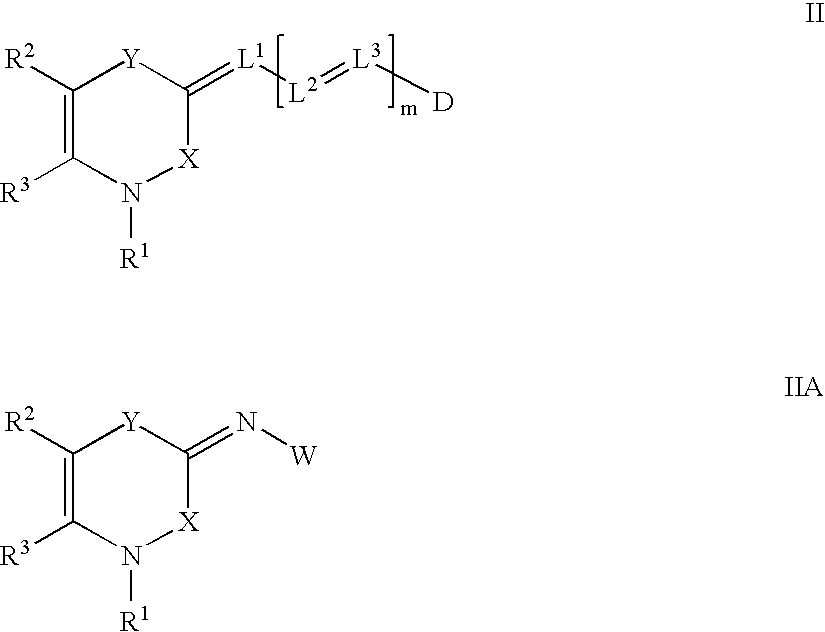Benzothiazine dyes for imaging elements
- Summary
- Abstract
- Description
- Claims
- Application Information
AI Technical Summary
Benefits of technology
Problems solved by technology
Method used
Image
Examples
example 1
[0087]A general synthesis of the 3,4-dihydro-1H-2,1-benzothiazin-4-one nucleus has been published (Lombardino et. al, Org. Prep. Proc. Int. 1971, 3(1), 33) and (U.S. Pat. No. 3,303,191). The dyes of Formulae II, IIA, III and IIIA can be prepared by synthetic techniques well known in the art, as illustrated by the synthetic examples below. Such techniques are further illustrated, for example, in “The Cyanine Dyes and Related Compounds”, Frances Hamer, Interscience Publishers, 1964.
Synthesis of Dye 1-11
[0088]Under nitrogen, triethylamine (1.409 grams, 0.0139 mol) was slowly added to a stirring slurry of 3,4-dihydro-1-ethyl-2,1-benzothiazin4-one 2,2-dioxide-7-carboxylic acid (3.00 grams, 0.0111 mol) and glutacondialdehydedianil hydrochloride salt (1.59 grams, 0.0056 mol), in 30 ml absolute ethanol. The solution turned blue instantaneously upon the addition of triethylamine. The reaction was then monitored by HPLC and allowed to proceed at room temperature until completion. The slurry w...
example 2
Fluorescence Characteristics of Benzothiazine Pentamethine Oxonol Dyes
[0093]Solutions of dyes 1-1, 1-6 and Comparative Dyes A and B were each prepared in MeOH at a concentration of approximately 0.005 g / L. The solution absorbance maxima were measured, and the extinction coefficients calculated. Each MeOH solution was diluted ten-fold with MeOH to produce dye solutions at a concentration of approximately 0.0005 g / L, and the fluorescence of these solutions were measured with a fluorimeter (scan speed 60 nm / min; slit width 4.5 nm). In each case, the excitation wavelength was identical with the λmax for each dye. The resulting emission characteristics (Primary Fluorescence Emission Maxima and Primary Fluorescence Intensity Maxima) were measured. The results appear in Table 11.
[0094]
TABLE 11Comparative DyesComparative Dye AComparative Dye BλmaxεmaxPrimary FluorescencePrimary FluorescenceDye(nm)(× 104)Emission MaxIntensity Max1-16506.3675 mm8.31-66632.9699 mm0.1Comp A58716.6 613 mm462.0
[...
example 3
Dye Wandering and Stain Evaluation
[0096]Dyes according to formulae (II) and (III) were prepared as solid particle dispersions by ball-milling according to the following procedure. Water (21.7 ml) and a 6.7% solution of Triton X-200™ surfactant (2.65 g) were placed in a 60 ml screw-capped bottle. A 1.00 g sample of dye was added to this solution. Zirconium oxide beads (40 ml, 2 mm diameter) were added and the container with the cap tightly secured was placed in a mill and the contents milled for four days. The container was removed and the contents added to a 12.5% aqueous gelatin (8.0 g) solution. The new mixture was placed on a roller mill for 10 minutes, and the resulting mixture was filtered to remove the zirconium oxide beads. The resulting dye dispersion had a particle size mean diameter lees than 1.0 μm.
[0097]The solid particle dispersions of these dyes were coated on a polyester support according to the following procedure. A spreading agents. (surfactant 10G™, and a hardener...
PUM
 Login to View More
Login to View More Abstract
Description
Claims
Application Information
 Login to View More
Login to View More - R&D
- Intellectual Property
- Life Sciences
- Materials
- Tech Scout
- Unparalleled Data Quality
- Higher Quality Content
- 60% Fewer Hallucinations
Browse by: Latest US Patents, China's latest patents, Technical Efficacy Thesaurus, Application Domain, Technology Topic, Popular Technical Reports.
© 2025 PatSnap. All rights reserved.Legal|Privacy policy|Modern Slavery Act Transparency Statement|Sitemap|About US| Contact US: help@patsnap.com



